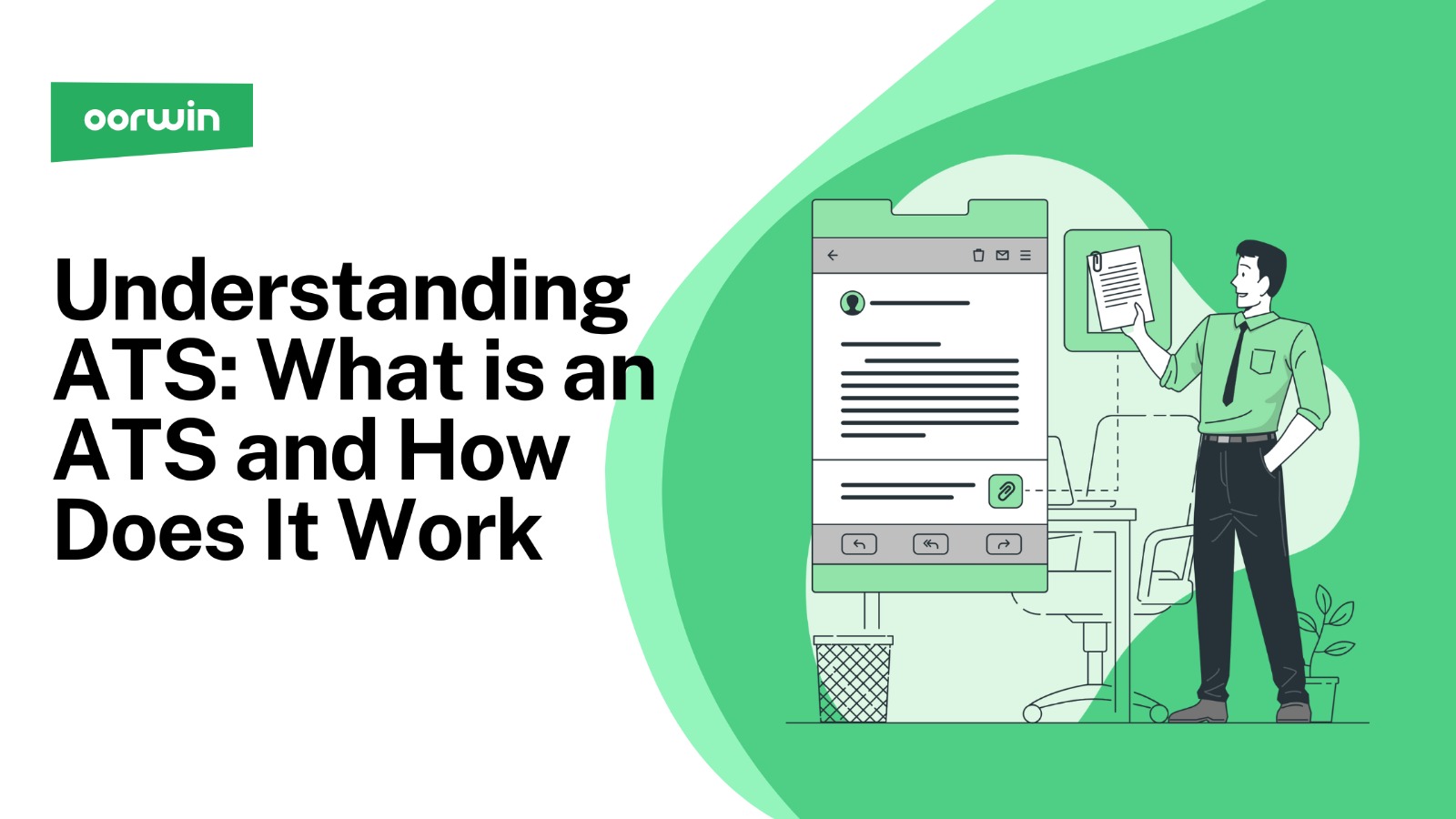Understanding ATS: What is an ATS and How Does ATS Work
Oorwin
10min read / 9 Jul 2021

Related Articles
A Comprehensive Overview of ATS: What is ATS and How Does an ATS Work
In today’s competitive job market, efficient and streamlined recruitment processes are crucial for businesses to find and hire the right talent. This is where an Applicant Tracking System (ATS) comes into play. Understanding what is ATS and how does ATS work is crucial for both employers and job seekers. In this article, we will delve into the world of ATS and explore its functionalities, benefits, and the importance of selecting the right system for your organization.
What is an Applicant Tracking System (ATS)?
An ATS, or Applicant Tracking System, is a software tool designed to automate and enhance recruitment. It is a central hub for managing job postings, storing applicant data, and streamlining the hiring process. Beyond these essential functions, an ATS can significantly improve the efficiency of recruitment teams by automating communication with candidates, scheduling interviews, and providing detailed analytics on the recruitment process.
Furthermore, an ATS plays a key role in helping recruiters sift through large volumes of applications. It uses advanced algorithms to scan resumes and applications for specific keywords and criteria, ensuring that only the most relevant candidates are shortlisted for further review. This not only saves time but also helps in maintaining a high standard of candidate selection.
How Does an ATS Work
ATS works by centralizing the recruitment process and automating various tasks. It receives resumes and job applications, stores applicant data, schedules interviews, and sends notifications to applicants. The primary goal of an ATS is to ensure that job openings are filled efficiently and that recruiters can easily manage and track applications. By filtering candidates based on criteria like skills and experience, it helps focus on the most qualified applicants. Additionally, features like keyword matching streamline the selection process, enhancing recruitment efficiency and fairness. Essentially, ATS simplifies recruitment tasks, enabling better focus on strategic hiring decisions.

Key Features of an ATS
Applicant Tracking Systems (ATS) have revolutionized the recruitment landscape, offering many features that streamline the hiring process. These systems simplify the task of managing applications and enhance the overall efficiency and effectiveness of recruitment strategies. Below are some key features that make ATS an indispensable tool for modern HR professionals.
Publishing a career page
On your firm website, you can post open opportunities on your career page. You may administer it straight from the platforms of many ATSs. The ATS makes the setup simple, with a spot to post pictures, logos, descriptions, social share buttons, and more to help market your opportunities.
Candidates frequently visit your jobs page after viewing one of your job postings elsewhere, so creating a page that matches your company’s values and lists the open opportunities is crucial.
Job distribution
Your chances of finding the ideal candidate can be maximized by posting your job opening on as many job sites as possible. Several major job boards, including Indeed, Monster, CareerBuilder, and ZipRecruiter, have alliances with applicant tracking systems. This implies that you can quickly post your job posting to all these websites after creating it with a few clicks.
You can distribute your job posting over several job boards using your applicant tracking system (ATS), and you can keep track of which panels are generating the most applications so that you can change your distribution tactics accordingly.
Sorting applications
Once your job posting has been written and sent across several job boards, it’s time to begin reviewing applications. You may rapidly examine and categorize your applications after collecting them into one database using an applicant tracking system (ATS).
Every applicant tracking system sorts and arranges applications differently, and some can automatically weed out candidates who don’t meet the requirements for the position. Nowadays, many ATSs include AI software that applies intelligent automation to screening and shortlisting resumes by matching candidates to the resumes of your current employees.
Resume Storage
A candidate’s resumé is kept in your applicant tracking system each time they apply for one of your job openings. Even after the position has been filled, the system controls all the applications it has received.
This is helpful if you need to hire more staff or believe the applicant would be a fantastic fit for another position. You will always keep track of an excellent candidate because the ATS will keep track of all candidates.
Onboarding tools
After you’ve chosen your newest hire, it’s time to start the onboarding procedure. The time it takes to hire and formally fill your available position can be sped up using an applicant tracking system for onboarding. Studies have found that, on average, it takes up to 32 days to fill a position, that too with an ATS. Without an ATS, the period can be much more extended.
Many systems begin with a warm welcome to the team, an introduction to the business, and an explanation of what to anticipate from new hires. You might include informational pages with breakdowns of employee benefits and other crucial details for the new hire to access. The new hire can then complete the necessary documentation to ensure they are prepared for their first day on the job.
Advanced Search and Filtering
ATS systems are equipped with powerful search and filtering capabilities. This feature allows recruiters to conduct detailed searches using various criteria such as keywords, job titles, skills, educational background, and previous work experience. The advanced search functionality is particularly useful in narrowing down the vast pool of candidates to those who best match the job’s specific requirements. This precise filtering saves time and ensures that the recruitment process is more targeted and effective.
Email Templates and Communication Tools
Most ATS platforms offer a range of customizable email templates and communication tools. These features enable recruiters to communicate consistently and professionally with candidates throughout the hiring process. Whether it’s sending out interview invitations, job offers, or rejection letters, these templates can be tailored to reflect the company’s brand and tone. Additionally, automated follow-up emails and reminders can be set up, ensuring that candidates are informed and engaged.
Real-Time Collaboration
An ATS facilitates real-time collaboration among various stakeholders involved in the hiring process. This includes HR professionals, hiring managers, and department heads. The system allows for shared access to candidate information, feedback, and evaluations, enabling a collaborative decision-making process. This feature is particularly beneficial in organizations where multiple departments or teams are involved in selecting a candidate, ensuring that all perspectives are considered, and the best hiring decisions are made.
Event-Triggered Automation
Event-triggered automation is a key feature of modern ATS systems. This functionality allows the system to perform certain actions automatically when specific conditions are met. For example, sending a welcome email when a candidate’s status changes to ‘hired’ or notifying the hiring manager when a new application is received. This automation significantly enhances the efficiency of the recruitment process, reducing manual work and ensuring timely actions.
Integration with Other Systems
Many ATS platforms offer integration capabilities with a variety of other software systems. This includes CRM (Customer Relationship Management) systems, email marketing tools, HR management software, Job portals and more. Such integrations enable a seamless workflow, allowing data flow between different systems effortlessly. This interconnectedness ensures that all aspects of the recruitment process, from candidate sourcing to onboarding, are streamlined and efficient, providing a comprehensive solution for HR management.
By incorporating these features, your ATS becomes a comprehensive tool for managing the entire recruitment process, from job posting to onboarding, ensuring a seamless experience for both recruiters and candidates.
The Top Benefits of an ATS
The most well-known benefit of an ATS is that it allows you to streamline and refine the entire recruitment process. In addition to this, the proper ATS will also provide the following benefits:
- Reduced hiring time: An ATS streamlines the recruitment process, enabling faster candidate sourcing, screening, and selection. This leads to a more efficient hiring cycle.
- Increased collaboration: ATS facilitates seamless communication and collaboration between recruiters and candidates, enhancing the overall hiring experience.
- Actionable insights and reports: ATS provides valuable data and analytics, allowing recruiters to make informed decisions and optimize their recruitment strategies.
- Improved quality of hire: By leveraging advanced candidate screening and matching capabilities, ATS helps identify the most suitable candidates for the job.
- Integration with third-party apps: Many ATS platforms offer integrations with various tools and services, enhancing the overall functionality and efficiency of the recruitment process.
- Enhanced employer branding: ATS enables organizations to create branded career pages and provide a positive candidate experience, thus strengthening their employer brand.
Assessing the Effectiveness of ATS Software
Applicant Tracking Systems (ATS) are designed to streamline the recruitment process, but their accuracy is debatable. While they offer time-saving benefits to recruiters, their effectiveness in identifying the best candidates is sometimes unreliable.
Research conducted by Harvard Business Review highlights a significant concern: about 88% of recruiters believe that ATS may inadvertently overlook qualified candidates. This issue arises because these systems heavily rely on matching resumes with the specific keywords outlined in job descriptions. Consequently, candidates who don’t use these exact keywords, despite having relevant skills and experience, might be excluded from consideration for the job analysis.
This reliance on keywords suggests a potential flaw in how ATS evaluates candidates, often neglecting the broader context of a candidate’s overall capabilities and professional background. As a result, many skilled and suitable applicants are bypassed, not due to a lack of qualifications but because their resumes lack certain keywords.
To navigate this system effectively, job seekers should tailor their resumes to each job application. This involves closely analyzing job descriptions and incorporating the keywords employers will likely use in their ATS. By doing so, candidates can enhance their chances of passing through the ATS filters and getting their resumes reviewed by human recruiters.

Signs Your Business Needs an ATS
You’re missing out if your business is still manually processing job applications. An ATS can reduce staffing costs by streamlining tasks like screening applicants and scheduling interviews. It also frees up more time for strategic tasks contributing to business growth.
- Manual processing of job applications: If your organization is still manually managing job applications, it’s time to consider implementing an ATS to automate and streamline the process.
- High staffing costs: An ATS can significantly reduce staffing costs by automating time-consuming tasks and freeing up recruiters’ time for strategic activities.
- Need for improved efficiency and scalability: If your recruitment process is becoming overwhelming and you’re struggling to handle increasing volumes of applications, an ATS can help you manage and scale your hiring efforts effectively.

Choosing the Right Applicant Tracking System for Your Business
Choosing the right Applicant Tracking System is crucial. There are several factors to consider:
Understanding the Purpose of an ATS
If you’re unsure about what is ATS and how does ATS work, it’s essentially a software tool that helps streamline your recruitment process. It screens, tracks, and stores data about candidates and schedules interviews. When selecting an ATS, it’s critical to understand its purpose, as this will impact the time and money spent on the technology in the long run.
Here is a guide for choosing the correct Applicant Tracking System-
Focusing on Your Recruitment Needs
Understanding what is ATS is and its functionalities is important, but every company has a different hiring process, and it’s essential to know what yours entails. Scheduling trials with various ATSs can help you decide which is best for your needs and may even provide insight into each system’s features.
Evaluating the Software
Before finalizing an ATS, assessing multiple recruiting software solutions is important. If you’re unclear on what ATS is and its benefits, a trial or demo can help determine which program best suits your organization’s needs.
Opting for an ATS with Mobile Optimization
Another key question when considering what is ATS for your organization is to verify if it has a mobile version. A mobile-optimized ATS enables candidates to apply for jobs and contact recruiters anytime, anywhere.
Checking for Data Security
For anyone asking, “what is ATS?” it’s crucial to note that data security is a significant concern. An ATS stores sensitive information about candidates and company members, so it’s essential to ensure all data is treated in respect to privacy policies.
Here are the top 10 Applicant Tracking Systems that companies can choose from, listed based on their features and customer reviews.
Streamlining Recruitment with Oorwin ATS
As the job market continues to evolve, the importance of an efficient and effective ATS cannot be overstated. Oorwin’s ATS emerges as a key player in this domain, providing businesses with the tools they need to navigate the complexities of recruitment in today’s fast-paced world. By choosing Oorwin’s ATS, companies are not just adopting a software solution; they are embracing a strategic partner in their journey toward recruitment excellence and organizational success.
Frequently Asked Questions
What is ATS?
An applicant tracking system (ATS) is a software tool that automates and streamlines recruitment. It helps companies manage job applications, track candidates, schedule interviews, and hire the right talent efficiently.
What is an applicant tracking system example?
Popular examples of applicant tracking systems include Oorwin, Workday Recruiting, iCIMS, Bullhorn, Jobvite, and Lever. These platforms offer a range of features to simplify and optimize the recruitment process for organizations of all sizes.
What ATS is used by companies?
Companies use various applicant tracking systems based on their specific needs and preferences. Some commonly used ATS platforms include Oorwin, Workday Recruiting, Greenhouse, Oracle Taleo, SAP SuccessFactors, and BambooHR. The choice of ATS depends on factors such as company size, industry, and recruitment requirements.
Popular Articles..
Blog

7min read / 25-Jun-2025
Master Effective Interview Techniques with Oorwin: A Step-by-Step Recruiter’s Guide
Blog
Blog
Get the latest Oorwin releases, updates, success stories & industry news
 Back
Back
